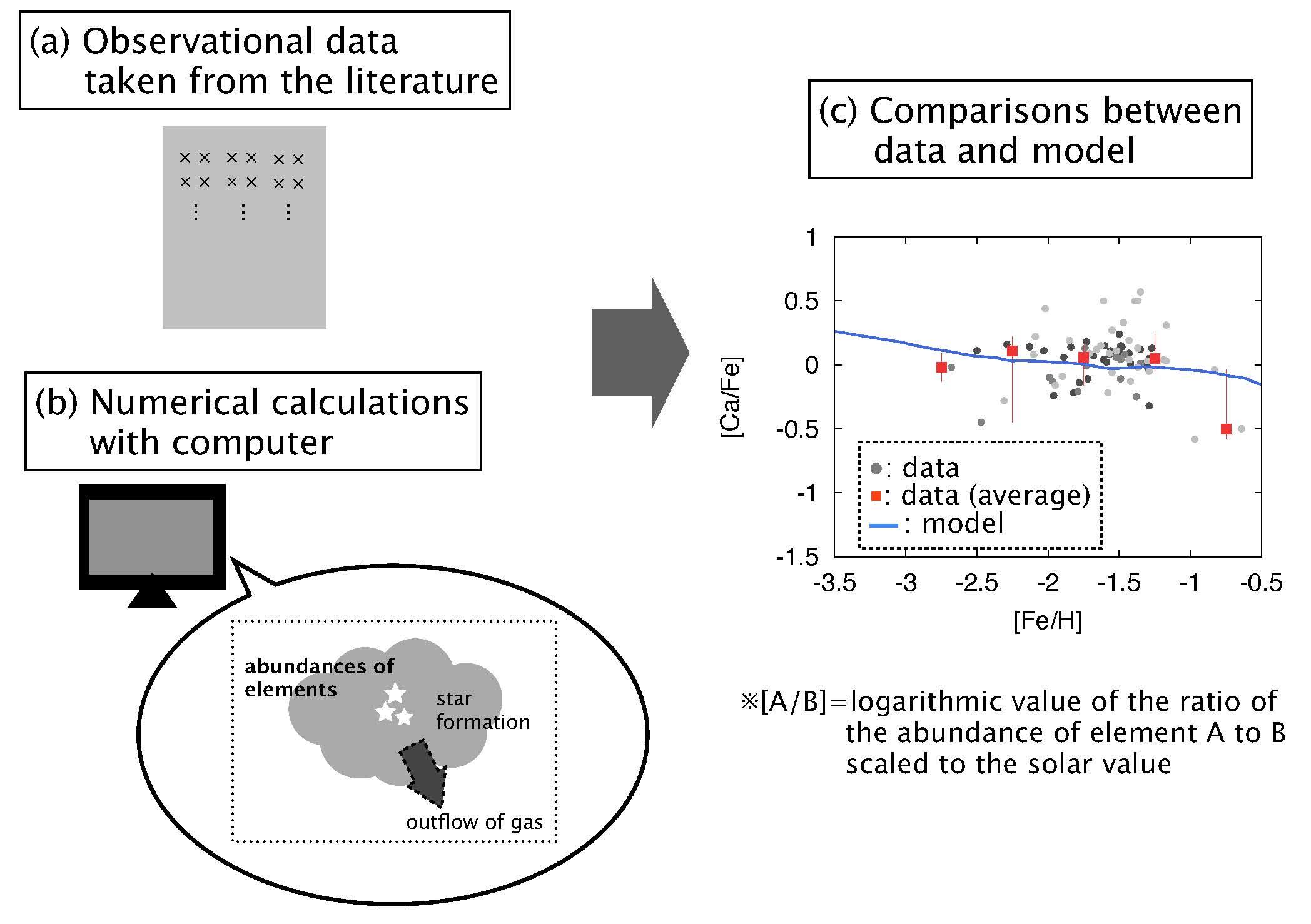2020.08.06
Chemical enrichment in the low-metallicity environments from the viewpoint of chemical abundances of dwarf galaxies
SOKENDAI Student Dispatch Program program year: 2019
Astronomical 深川奈桜
天文科学コース

(a) Observational data about individual dwarf galaxies are taken from the literature. (b) The chemical abundances of the galaxies are estimated by numerical calculations using a computer. For the details on the theoretical model, see the text. (c) The predicted values and the observed abundances are compared. These figures are the case of the Carina dwarf spheroidal galaxy. Dots are the abundance ratio of individual stars from Norris et al.(2017, references therein). Red squares are the averages.
Do you know that there are low-mass galaxies around our galaxy? They are categorized into dwarf galaxies. According to the cold dark matter model (e.g. White & Rees 1978), massive galaxies are formed by mergers of less massive systems. Therefore, studying the evolution of dwarf galaxies provides insights into the characteristics of systems that can be building blocks of massive galaxies.
In general, the metallicities (the amount of elements heavier than helium) of dwarf galaxies are lower than those of massive galaxies. In a galaxy, stars are formed from the interstellar gas, and the stars release heavy elements into the gas. Through this cycle, galaxies become rich in heavy elements as time passes by. Thus, the abundances of elements in dwarf galaxies can be clues to understand how the elements are produced in the low-metallicity environments like the early universe.
In this study, observational data about chemical abundances of stars associated with individual nearby dwarf galaxies are compared to the theoretical model to discuss the sources of heavy elements in the low-metallicity environments. The model is realistic in that star formation histories of the galaxies derived in the literature are adopted. The amount of gas expelled from galaxies is also constrained based on the comparison between observed metallicity distribution of stars and those predicted by the model. In Figure 1(c), the abundance ratios of elements to iron in the atmosphere of stars associated to one of dwarf galaxies are compared to the model predictions. In the cases of calcium and magnesium, a large amount of which are produced through nucleosynthesis in massive stars, the general trends of observed abundances are roughly explained by the model. On the other hand, for several elements including scandium, vanadium and nickel, the model is inconsistent with the observed abundances, suggesting the need for other sources of these elements and/or the uncertainty of theoretical data about the amount of heavy elements released by stars. Thus, through such studies, one may test also our understanding of stellar nucleosynthesis.
This study is in progress, and the sources of heavy elements in the low-metallicity environments will be further discussed.
Period of Stay
Date of Departure: 29 October 2019
Date of Return: 29 February 2020
Country and/or City
France
Visiting Institute, Host, or Meeting
Institut d'Astrophysique de Paris
What you learned and achieved during the visit
This article is based on the study conducted at l'Institut d'Astrophysique de Paris (IAP) during the visit from 1 November 2019 to 28 February 2020 which is supported by the SOKENDAI Student Dispatch Program. The participant is deeply grateful to Dr. Nikos Prantzos for insightful comments and discussions on stellar yields and chemical evolution models. Through having lunch and coffee with researchers at IAP, the participant also realized that it is important to take interest in cultures and societies.
Department of Astronomical Science, Nao Fukagawa
